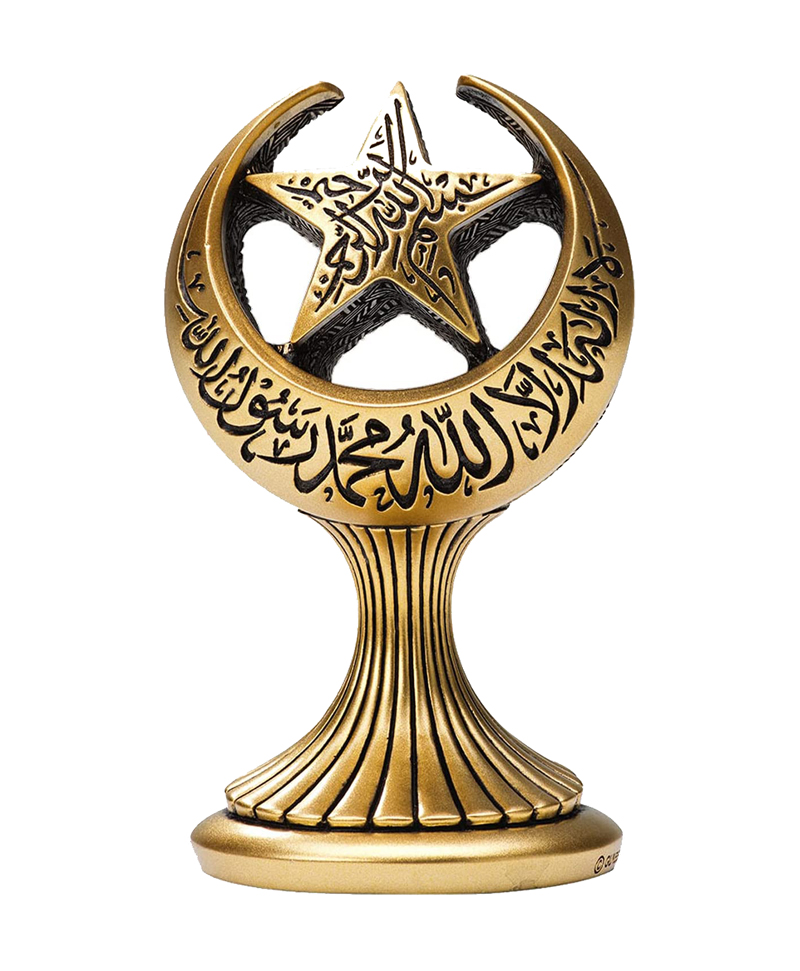Islamic Gold Moon and Star with Tawhid Statue
This Islamic Gold Moon and Star Statue is made of polyester, making this a strong Islamic trinket so being durable and made to last. Excellent and unique designed model produced in Turkey to create an harmonious spiritual environment as a decoration. This work of art is full of verses embroidered and is made with the finest craftsmanship and the finest materials, resulting so in an object of incredible value. The Star and Crescent Moon is an iconographic symbol used in various historical contexts, including as a prominent symbol of the Ottoman Empire, with numerous modern countries still using it as a national symbol. It was developed in the Greek colony of Byzantium 300 BCE, though it became more widely used as the royal emblem of Pontic King Mithradates VI Eupator after he incorporated Byzantium into his kingdom for a short period. During the 5th century, it was present in coins minted by the Persian Sassanian Empire. The symbol was represented in the coins minted across the empire throughout the Middle East for more than 400 years from the 3rd century until the fall of the Sassanians after the Muslim conquest of Persia in the 7th century.
The conquering Muslim rulers kept the symbol in their coinage during the early years of the caliphate, as the coins were exact replicas of the Sassanian coins. The symbol is the conjoined representation of a Crescent Moon and a Star. Both elements have a long prior history in the iconography of the Ancient Near East as representing either the Sun and Moon or the Moon and the Morning Star (or their divine personifications). Coins with crescent moon and star symbols represented separately have a longer history, with possible ties to older Mesopotamian iconography. The star, or Sun, is often shown within the arc of the crescent (also called star in crescent, or star within crescent, for disambiguation of depictions of a star and a crescent moon side by side). In Numismatics in particular, the term crescent and pellet is used in cases where the star is simplified to a single dot. The combination is found comparatively rarely in late medieval and early modern heraldry. It rose to prominence with its adoption as the flag and national symbol of the Ottoman Empire and some of its administrative divisions (eyalets and vilayets) and later in the 19th century Westernizing tanzimat (reforms). The Ottoman flag of 1844, with a white ay-yıldız (Turkish for “crescent-star“) on a red background, continues to be in use as the flag of the Republic of Turkey, with minor modifications.
Other states formerly part of the Ottoman Empire also used the symbol, including Libya (1951-1969 and after 2011), Tunisia (1831) and Algeria (1958). The same symbol was used in other national flags introduced during the 20th century, including the flags of Azerbaijan (1918), Pakistan (1947), Malaysia (1948), Singapore (1959), Mauritania (1959), Uzbekistan (1991), Turkmenistan (1991) and Comoros (2001). In the later 20th century, the star and crescent moon have acquired a popular interpretation as a “Symbol of Islam“, occasionally embraced by Arab nationalism or Islamism in the 1970s to 1980s but often rejected as erroneous or unfounded by Muslim commentators in more recent times. Unlike the Cross, which is a symbol of Jesus’ Crucifixion in Christianity, there is no solid link that connects the star and crescent moon symbol with the concept of Islam. The connotation is widely believed to have come from the flag of Ottoman Empire, which was one of the largest empires of the early modern period. Unicode introduced a “star and crescent moon” character in its Miscellaneous Symbols block, at U+262A (☪).
The term Tawhid instead, also spelled Tauhid, Arabic Tawḥīd, “making one“, “asserting oneness“, in Islam, the Oneness of God, in the sense that He is One and there is no God but He, as stated in the shahādah “witness” formula: “There is no god but God, and Muhammad is His prophet“. Tawhid further refers to the nature of that God, that He is a Unity, not composed, not made up of parts, but simple and uncompounded. The doctrine of the Unity of God and the issues that it raises, such as the question of the relation between the essence and the attributes of God, reappear throughout most of Islamic history. In the terminology of Muslim mystics (Sufis), however, Tawhid has a pantheistic sense, all essences are divine, and there is no absolute existence besides that of God. To most Muslim scholars, the science of Tawhid is the systematic theology through which a better knowledge of God may be reached, but, to the Sufis, knowledge of God can be reached only through religious experience and direct vision. Gold Moon and Star with Tawhid Statue sizes: 6 inches / 15 cm x 9 inches / 23 cm.
Islamic Gold Moon and Star Statue on Amazon.
Islamic Gold Moon and Star Statue on eBay.
Religious Statues, Islamic Statues and Planets Statues.




You must be logged in to post a comment.